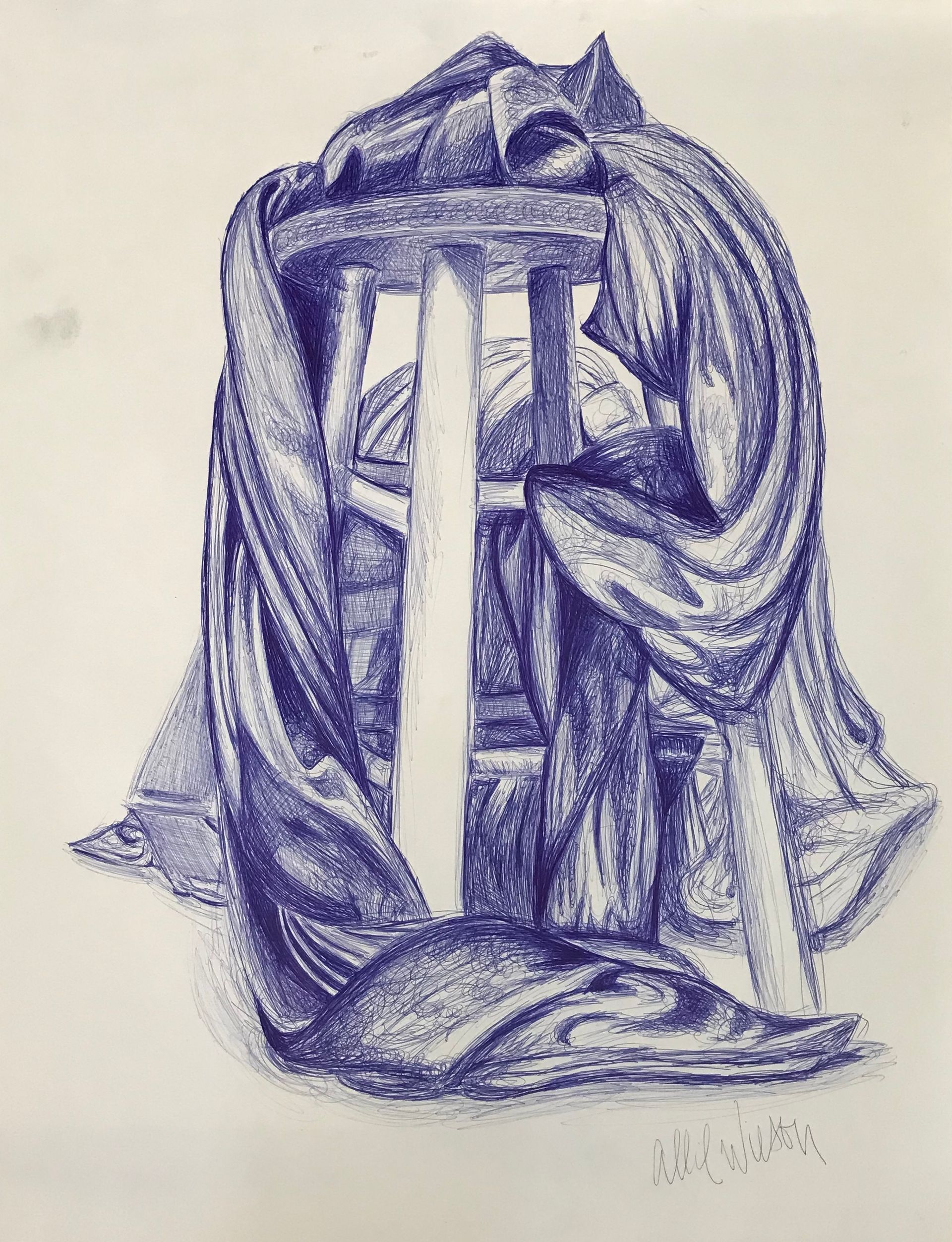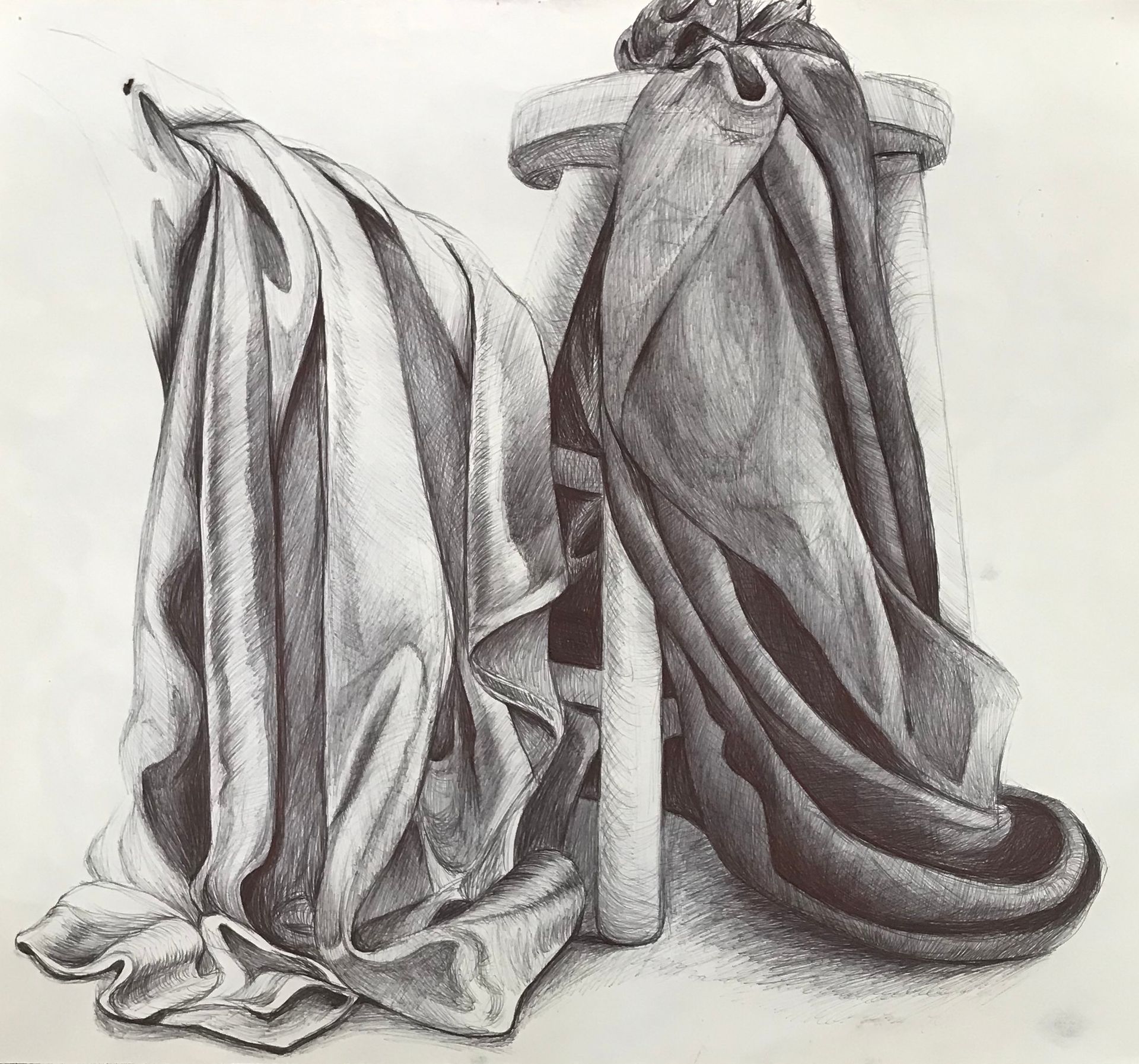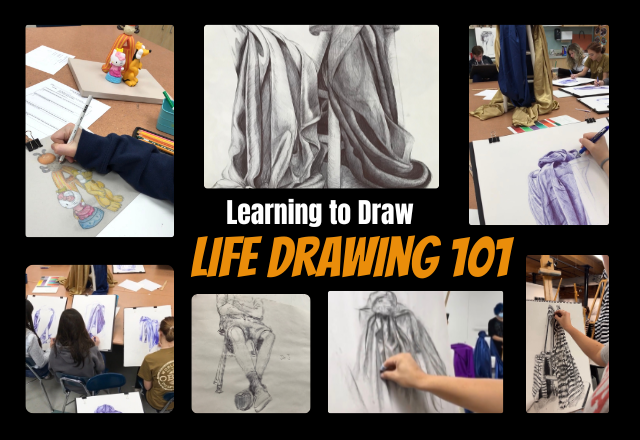Life Drawing is our End Game when it comes to learning to draw. As I mentioned in the last blog post, I teach Drawing on a scaffolded approach. Line first, then Shape, then Value, then Color and so on…we add drawing “tools” to our artist toolbox one skill at a time.
This is a foolproof Drawing scaffold for students at the middle or high school level. I can say this with confidence because I have seen it happen over and over again. It’s all about that first shape.
The first skill is line drawing (See Previous Blog Post). Once students have a firm grip on reading a reference in sections (Quadrant Method example below) and they understand right-brained drawing theory, we move on to building objects using basic shapes.

The End Game
I explain early on that the end game is life drawing. We will do a lot of life drawing of a wide variety of subject matter – fabric, people, hands, glassware, etc. – all very challenging. I also tell them that my goal for them is to be confident artists. To not be intimidated by anything. That none of what we do is busy work, it all serves a greater purpose or as I call it, “The method to my madness.”
As a result, there is never (and I’m serious, never) any pushback, questioning, arguing or asking, “why are we doing this?” or “why do we have to do this?” or any feedback whatsoever. The value of the lesson has already been stated. The work from advanced students is on the wall (everywhere) for the beginners to see. I reference it often and tell them, “these students were once drawing a squirrel and shading it just like you are. Now look where they are.”
We’re A Part of Something Special
We also have a strong community focused on working toward a common goal (community building details) of becoming amazing artists. This adds to the confidence and the trust the kids have in me that I have their best interests at heart. And I do. We leave no man behind. And we don’t. I want nothing more than for them to be amazing artists, skilled and self-assured to tackle any task that is set before them. All of them.
We have quite a few students who attend art schools every year. Right now we have students at RISD, NC State School of Design, Ringling, VCU School of the Arts and Pratt. They ALL contact me within the first year and tell me how grateful they are to have life drawing skills as many of their peers are frozen with fear due to a lack of basic observational drawing experience.
Life drawing is difficult. It’s difficult to teach and it’s difficult to do (over Zoom it’s quite the feat), especially as a distracted teenager. But it’s necessary. The artist needs a strong eye for many reasons. There are no grids in life drawing. There is only the object in space and your ability to interpret it and transfer it to your paper or canvas. This advanced skill has its origins in building objects using basic shapes.
So here we are, full circle back to the shape thing.
I keep it REAL simple in the beginning of each new skill. Small drawings. Big victories.
My Drawing 1 students are working on a series of skill builder worksheets that begin with flat animated images (lesson) and then progress into shaded toy drawings (I photograph the toys for the worksheets – the toy worksheets are on the way to the shop shortly).
Because we are virtual (for the most part – a few students come for hybrid but not many) I have them doing twice as much practice because I want to keep the assignments small so the victories are big. Being at home makes being motivated very challenging. The smaller the acreage in paper they have to cover, the more likely the success.
These exercises focus on scaling up an object (or character) while still maintaining the correct proportions. I give them exact instructions, down to how tall each character needs to be. I include step-by-step narrated tutorials that accompany the exercises so kids can watch the demo more than once. They have given me good feedback that this really helps as they often watch the videos more than once and are able to also slow them down when needed. (lesson)
It’s all about that first shape.
I am constantly reminding them that the first shape sets the tone for the size of the entire object. Drawing is about relationships, in this instance relationships between shapes. They learn how to evaluate which relationships between shapes affect subsequent shapes and that one wrong shape can throw the entire drawing out of whack.
It’s all about a strong eye. An eye for angle and pitch and width and length of shapes that create a foundation for the finished object. They are learning to see all over again. When we tackle foreshortened objects in a live setting they are no more intimidated than when we tackled the forgery challenge (more on this challenge here).
They are confident and sure that even if they don’t know how to do it now, they very soon will. All of them. Together. It’s like getting a shot of electricity when they say, “wow, I can’t believe I drew that…” with wonder and amazement.
We do a series of pen and ink drawings in my Drawing 2 class and we finish with a fabric still life. On a sheet of 18 x 24 paper. In blue ballpoint pen. With no pencil foundation first. Just. Pen. They are nothing short of incredible. All of them. There are examples on our Instagram @mrstfoxresources – scroll down through the feed, you’ll see them. A few examples are at the bottom of this page.
There is no way the kids would tackle this with such energy without these foundational lessons. I would go to the mat that these are indeed the most important lessons in learning to draw – especially from life. Once kids have these skills on board, any subject matter you throw at them will not intimidate them. The logic is the same no matter what they are drawing. Build it with shapes. Refine it. Add color….build it with pen….add value…easy. Peezy. They can take these skills and expand into digital drawing.
Below are some of my favorite advanced lessons that take their shape (pun intended) once these valuable drawing skills have been established. The shoes and the bow are Drawing 1 (intro) – the Paint Blob and the Food are Drawing 2 (Intermediate). Feel free to click on the images to see details on the lessons.
Be Among the First to Know
Please join my email list for “The Weekly Fabulousness” Newsletter, and get cool Art Teacher Freebies, new and updated product info, and Art Educator PD Workshop Dates (email subscribers get first dibs on seats!)
Not sure you’re interested in being on the list?
Check out my teaching style with a FREE Mini-Workshop!
Each one comes complete with classroom resources. Take all six!
Choose from these FREE workshop topics:
- Colored Pencil Basics
- Colored Pencil Skin Tones
- How to Draw the Human Eye
- Art Task Cards – Drawing on a Grid
- How to Draw Ice Cream
- Acrylic Painting Basics
Have a wonderful and safe year and Happy Teaching!
Tiff 🙂




Share This Post